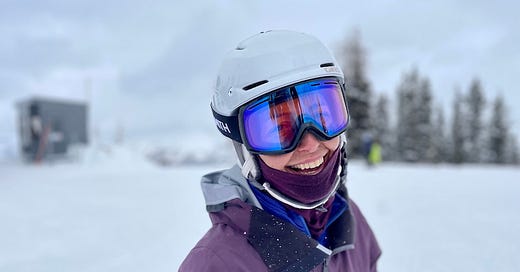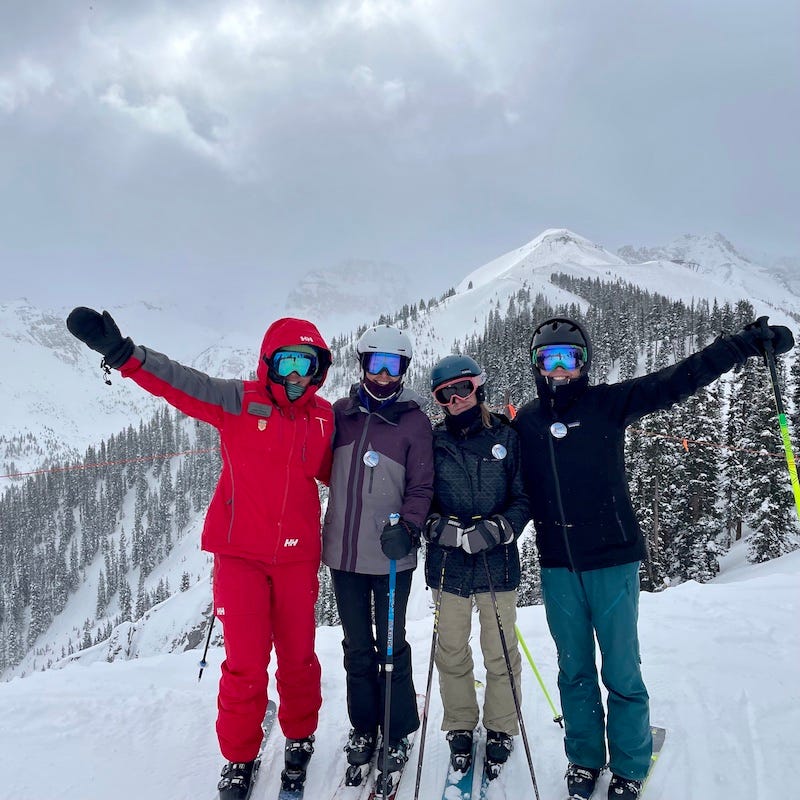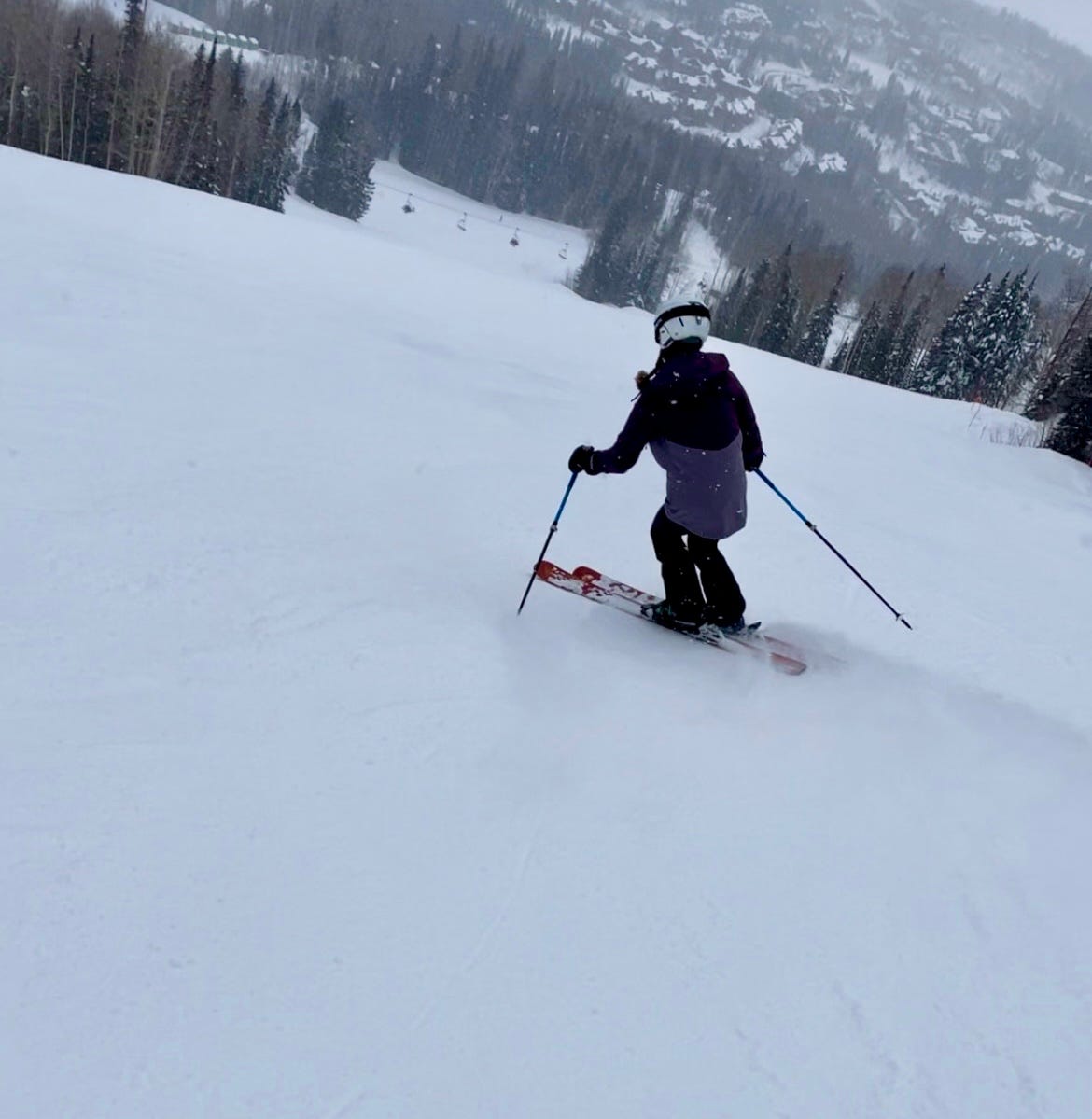Welcome back. This week’s post relates to a story I wrote three weeks ago, “Winter, I’m Just Not That Into You,” about winter wimpiness and a preference for the warmth and colors of summer and fall. It’s also about being a lifelong learner with a growth mindset, trying to cultivate a new skill through effort and practice rather than concluding “I suck at [fill in the blank], so it’s not my thing.” I’d love to hear if you’ve had a similar experience trying to learn a new sport or craft; you can comment at the end or on the chat thread.
“Life is not a series of groomed runs. You’ve gotta learn to get over the bumps and down the steeps,” my ski instructor Linda exhorted when I met her.
I approached winter with a goal of learning to ski uphill by skinning, because I would like to experience the vigorous workout and adventure of backcountry skiing that so many mountain runners embrace in snowy months. I also felt I should try this winter sport, because I live in the San Juan Mountains with opportunities to ski every style. Being an all-around skier—alpine, Nordic, backcountry—feels almost like a litmus test for whether you’re a local. How could I live here and not embrace all that winter offers?
But I made no progress toward that goal because a realization hit with a big “duh”: There’s a decent chance I couldn’t get back down any mountainside that I skinned up, because I’m not a good enough downhill skier to handle unpredictable terrain. I stick to intermediate groomed runs, and when I watch advanced skiers go down the narrow chutes under the chairlifts, I’m mystified as to how they navigate those tight, bumpy turns around trees and exposed rock outcroppings. I see them and think, I could never do that, nor would I want to get stuck on terrain like that.
Basically, I’ve always been the skier’s equivalent of a couch-to-5K road runner who takes up jogging in advance of an annual neighborhood Turkey Trot, then crosses the finish line and doesn’t run for the next ten months. Just as that person wouldn’t self-identify as a runner, I wouldn’t call myself a skier, even though I ski several times in winter. I always feel more ambivalent than joyful about spending hours sitting on a lift and swooshing back down. If it weren’t for my husband and kids who love to ski and snowboard, I probably wouldn’t bother with all the gear and expense of a season pass.
What would it take for me to feel like a legit skier with the desire and skills of my family members? Exposure therapy, that’s what, in the form of all-day skiing with an instructor who would take me on runs I’ve been avoiding and, I hoped, could fix my form.
That’s why I dedicated last Friday through Sunday to skiing, to get out of a rut of mediocrity on intermediate runs. I wanted to give this sport a concerted try before concluding I’ll never ski well enough to truly enjoy it or to keep up with my husband, who carves nearly perfect fast turns on black-diamond runs. I also realized it was a prerequisite to branching out in the backcountry.
Thankfully, a specialty camp called Women’s Weekend takes place here in Telluride, which is a bargain for the level of instruction and support it offers compared to the steep price of regular lessons. I dedicated myself to three full days of skiing, which felt like a huge time investment given that I normally ski only for two hours at a time. Would I stick with it past the first day? Would it be worth it?
Let me pause here to acknowledge the privilege, escapism, and invaluable growth involved with going to a camp or retreat as an adult (and at the end of this story, I’ll offer some recommendations for camps this year). I’ve been to several running camps during adulthood, leaving my kids and husband behind, and each time I almost didn’t go because it felt selfish, expensive, and almost impossible to schedule. Something in regular life had to give to make it happen.
And yet, each getaway impacted me in profoundly positive ways. I doubt I’d be the mountain/ultra runner I am today if I hadn’t attended Geoff Roes’s Alaska ultrarunning camp in Juneau back in 2012. The confidence, skills, and friendships gained from those five days rippled into other areas of life in the following years.
Camps are “me-time” and can feel selfish, but I urge you to view it as an investment in your health and happiness—and even, in your relationship. As I learned in marriage therapy (which helped us stay married for the past 32 years), couples’ relationships tend to be stronger and longer-lasting when both individuals feel satisfied and have their own “thing” that nurtures self-worth, rather than feeling unfulfilled and overly dependent on their partner. It takes negotiation, and taking turns, for one person in a relationship to dedicate significant time to an individual pursuit, but it’s worth it. I’m blessed to have a husband who supports me taking off periodically to do my thing.
Linda, the instructor assigned to our group at Women’s Weekend, wore a beanie with a pom-pom, rather than a helmet, marking her as old-school. She had a stud in her nose and blue streaks in blond braids that gave her a youthful vibe, but she looked slightly older than I (later she told me she’s 61). Her jacket button said “Professional Ski Instructors of America—20 Years” and her name tag carried the tagline, “10,000+ Hours Strong.”
I liked her right away, and even more when she said, “I’m a ski more, talk less instructor—c’mon, let’s go! We can talk on the lift.”
She told me to trust her. More precisely, she got in my face and asked it as a challenging question—“Will you trust me?!” She wouldn’t take me down anything she didn’t believe I could handle. So I gave myself over to her guidance.
After the first two runs, I realized that I and another woman, who’s in her early 70s, were less skilled than the two other middle-aged women in our group. I also found out that our group—which had been listed as second-to-last on the camp’s roster of instructors and their groups—was the second-highest skill level. I had wrongly assumed from our placement near the bottom of the list that we were one spot away from being the least-skilled group. Gulp. I would be challenged, and we would go on advanced terrain. But that’s what I signed up for, so I had to be brave.
Linda wasted no time letting me know what I needed to do. Early on, I skied toward her with skis too far apart, kicking one out at an angle on turns, and then I stood next to her with my right foot’s boot askew instead of lined up next to the left foot. She half shouted, half laughed, “Stop it! Look at that wedge—you’re making my eyeballs bleed! I don’t want to see any wedges, any triangles. I don’t care if you’re used to standing like that; you need to develop new muscle memory. … You are not going to be able to get around bumps unless your skis are together!”
Later, when working on a bump run—a run I always avoided—she yelled at me, “Stop being a Walmart!” I figured out that she meant a big-box store, which is how my body looked with feet too far apart and upper body hunched. “Be a tall skyscraper!”
It worked. By being outrageously no-nonsense yet funny, and not sugarcoating what I was doing wrong, she helped me recognize and fix bad habits that inhibited my progress. She explained how to flatten and shift my feet and move my torso in ways that transformed my skiing. By Day 2, I was skiing parallel and fast enough to keep up with the others.
Linda got me to trust my downhill ski to “slay the headwalls.” We dove the tips of our skis into steep headwalls and used skiddy pivot turns to get down a black-diamond run’s steepest portions.
Perhaps most exciting, she got me to go on “goat runs,” the narrow paths that shoot off from the main runs. We started with the paths that skiers had carved on the sides of groomed runs, then progressed to connectors through trees. Linda shouted at us, “Play on the sides! Take a walk on the wild side!”
Approaching a goat run always took commitment emboldened by courage. Like threading a needle, I had to hit it just right right in terms of speed and angle in order to follow the track in the snow that prior skiers had made. When I did it—sometimes catching air over a little bump—I felt elated. When I changed my mind at the last second and turned away from the path, I told Linda I felt as if I had chickened out. She reassured, “It’s OK, it’s probably your brain’s way of making a smart decision. Something wasn’t right with your approach, so you made the right choice. Don’t be so hard on yourself!”
I’m honestly surprised and excited by how much I improved in three days. I will now make time to ski with eagerness and call myself a skier.
The experienced reinforced a few things I knew to be true but hadn’t experienced much at all, outside of running:
Mentors/coaches/leaders like Linda are powerful change agents who can teach old dogs new tricks.
You can’t improve unless you try new, uncomfortable challenges. And you may not be able to meet that challenge on your own, without the mentor or coach, which is OK and why it’s important to ask for guidance.
Don’t underestimate the power and skill of women over 50, especially when they’re together. And don’t judge their physical prowess by looks or body type. Several heavyset gray-haired ladies blew me away with their bad-assery on the slopes. We magnify our warmth, wisdom, and courage through camaraderie. Perhaps it’s because we gave so much earlier in life as caregivers, and many of us rode our husband’s coattails, that we hunger to let ’er rip, slay headwalls, catch air, scramble up summits, or whatever it takes to remind ourselves and show others that we are strong, impressive, and brave.
A few more camps & retreats
In addition to the Women’s Weekend ski camp described above, which takes place twice each winter—late January and early March—I recommend the following:
Any of the workshops or retreats at Ranchlands’ Zapata Ranch. Last fall, as detailed in this post, I attended a weeklong intermediate horsemanship clinic at the ranch. Yoga, writing, photography, drawing and other workshops take place at this working ranch, which promotes sustainable and regenerative ranching and agriculture.
Katie Arnold’s “Flow Camp”—Katie, an accomplished ultrarunner (former Leadville 100 champ) and writer, will host a four-day immersive camp for running and writing based at a hut near Telluride in the San Juan Mountains, from September 8 - 11. She’ll also host a desert version of the camp near Santa Fe in June and September. I have not participated in her prior camps, but I know Katie and trust this will be a highly worthwhile experience to unplug and find your flow both in running and writing. Follow Katie’s instagram for her forthcoming announcements on the camps, or email her katie@katiearnold.net to ask about it.
Trails Sisters’ women’s running retreats in Boulder—I haven’t taken part in these in past summers, but I respect founder and camp leader Gina Lucrezi and bet that her all-abilities camps are worthwhile and a safe, supportive space for beginners, plus a great way to run around Boulder. 2023 dates are June 1 - 4 and August 10 - 13.
Strava update
Lastly, I mentioned in a new year’s post that I got on Strava after resisting it for the past decade-plus. I was overly concerned Strava would negatively affect my training due to FOMO and virtual peer pressure; in other words, I might change my training out of self-consciousness about how it looked to others on Strava. Also, I felt I didn’t need Strava because of all the data and training log functionality I got from TrainingPeaks.
I thought, what the heck, I’ll give it a try and see if it’s a source of motivation. I’m happy to report that after a month, I’ve found it to be a refreshingly positive social media platform more than anything else—a place where I can check in and see what some friends are doing athletically, and exchange a virtual thumbs-up of encouragement.
But, now that I’m on it, I can appreciate the satire of this reel by comedian/runner Laura Green. I have not, however, altered the title of my runs or workouts in this way (not yet, anyway!). Check it out:
https://www.instagram.com/reel/CoCnRGCpuRz/







This camp sounds fantastic! I’m impressed that you made so much progress in just 3 days and found courage to tackle the black-diamonds and goat runs :) I’m a cautious blue-square skier myself and now I’m inspired by you to try to push out of my comfort zone - loved this article.
I can totally relate! We have a condo in MV and I hardly ever ski, though I do a ton of other winter activities when we’re there. I think it’s two things that hold me back: I hate crowds and standing in lines, and I fear knee injury that would limit my summer activities. Your post makes me think about skiing again. Thanks for the motivation :)